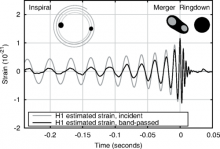
Abstract
We compare GW150914 directly to simulations of coalescing binary black holes in full general relativity, accounting for all the spin-weighted quadrupolar modes, and separately accounting for all the quadrupolar and octopolar modes. Consistent with the posterior distributions reported in LVC_PE[1] (at 90% confidence), we find the data are compatible with a wide range of nonprecessing and precessing simulations. Followup simulations performed using previously-estimated binary parameters most resemble the data. Comparisons including only the quadrupolar modes constrain the total redshifted mass Mz \in [64 - 82M_\odot], mass ratio q = m2/m1 \in [0.6,1], and effective aligned spin \chi_eff \in [-0.3, 0.2], where \chi_{eff} = (S1/m1 + S2/m2) \cdot\hat{L} /M. Including both quadrupolar and octopolar modes, we find the mass ratio is even more tightly constrained. Simulations with extreme mass ratios and effective spins are highly inconsistent with the data, at any mass. Several nonprecessing and precessing simulations with similar mass ratio and \chi_{eff} are consistent with the data. Though correlated, the components' spins (both in magnitude and directions) are not significantly constrained by the data. For nonprecessing binaries, interpolating between simulations, we reconstruct a posterior distribution consistent with previous results. The final black hole's redshifted mass is consistent with Mf,z between 64.0 - 73.5M_\odot and the final black hole's dimensionless spin parameter is consistent with af = 0.62 - 0.73. As our approach invokes no intermediate approximations to general relativity and can strongly reject binaries whose radiation is inconsistent with the data, our analysis provides a valuable complement to LVC_PE[1].